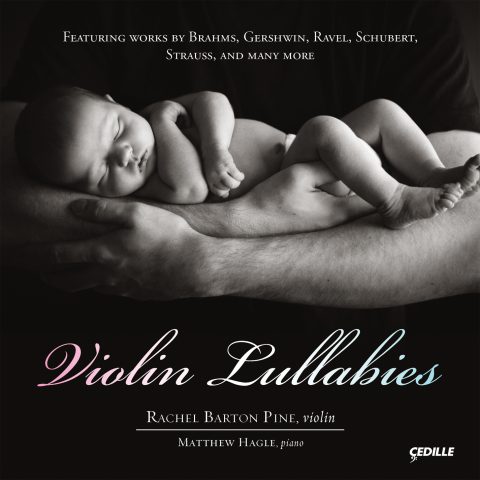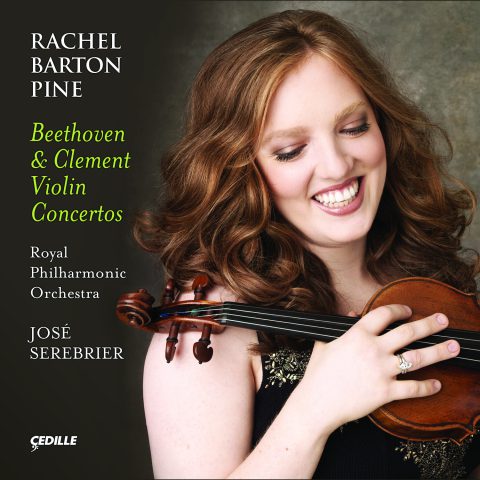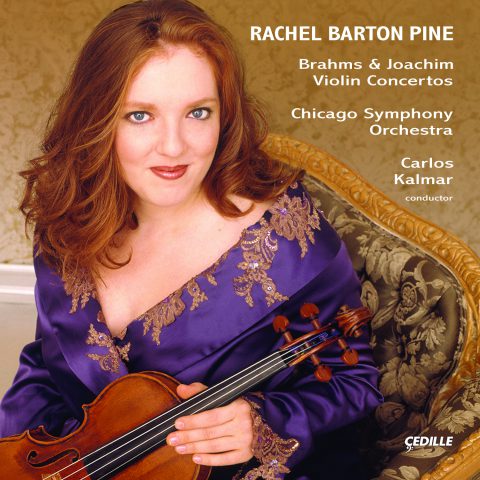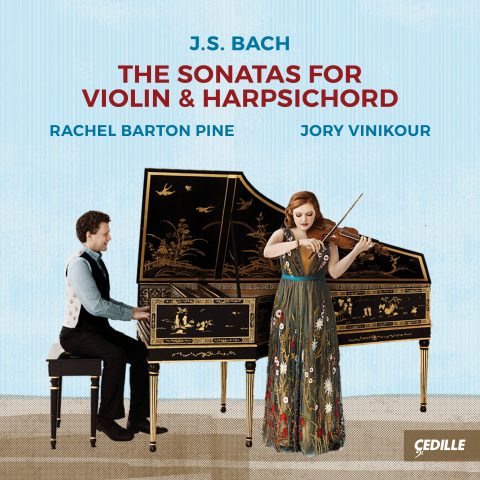Store
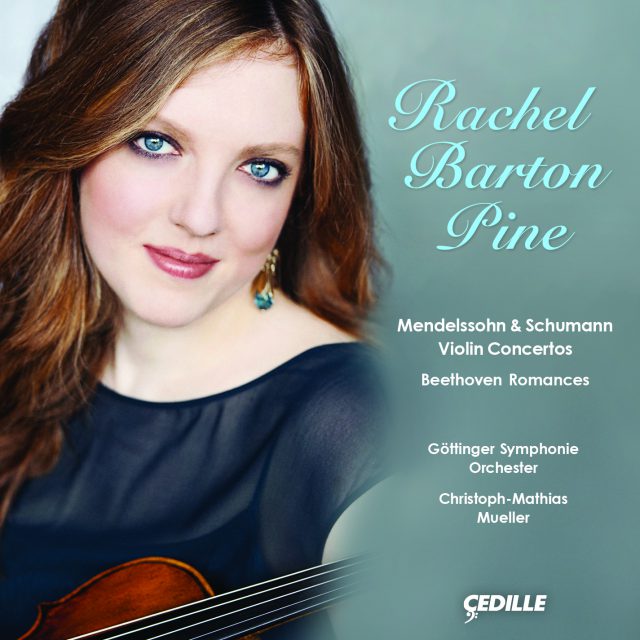
Store
Mendelssohn and Schumann Violin Concertos
Christoph-Mathias Mueller, Göttinger Symphonie Orchester
Billboard chart-topping violinist Rachel Barton Pine joins forces with Germany’s distinguished Göttinger Symphonie Orchester and its acclaimed principal conductor, Christoph-Mathias Mueller, to present Mendelssohn’s celebrated violin concerto alongside the great, though lesser-known, concerto by Robert Schumann, plus Beethoven’s elegant Romances for violin and orchestra. When the artists performed the Schumann in concert, they found the collaboration a revelatory experience. So they reconvened to record this program for listeners everywhere, with the invaluable help of multiple Grammy award-winning producer Steven Epstein.
“The Mendelssohn is one of those fiddle war horses that every young soloist plays but few can play as beautifully as [Pine]. Without resorting to any musical distortion, she invested the thrice-familiar phrases with a lyrical grace that seemed newly minted.”
— Chicago Tribune on Pine in concert
Preview Excerpts
FELIX MENDELSSOHN (1809–1847)
Violin Concerto in E minor, Op. 64
LUDWIG VAN BEETHOVEN (1770–1827)
ROBERT SCHUMANN (1810–1856)
Violin Concerto in D minor, WoO 23
BEETHOVEN
Artists
Program Notes
Download Album BookletMendelssohn and Schumann Violin Concertos, Beethoven Romances
Notes by Rachel Barton Pine
Madness and death, rejection and suppression, resurrection and redemption, Hitler, séances — the Schumann Violin Concerto is surrounded by drama and intrigue. Against this backdrop, the work’s merit continues to be debated. Is it an inferior piece that would be played less frequently were it not by a famous composer? Conversely, would it be more highly regarded if it wasn’t a work many consider (rightly or wrongly) to be not up to its great composer’s highest standards? Should our knowledge of Schumann’s mental health carry any weight in our judgment of his late compositions?
Robert Schumann (1810–1856) wrote his only Violin Concerto during a two-week burst of inspiration in autumn 1853, a happy period in which he met Brahms for the first time. Schumann dedicated the concerto to his friend, the great violinist, conductor, composer, and pedagogue, Joseph Joachim. Structurally, the work is conservatively classical. Grandly symphonic in conception, the first movement is in sonata-allegro form with a double exposition featuring a powerful opening theme. The development transforms a minor-key version of the warmly romantic second theme into quiet stillness, with fragments from the solo violin set against achingly beautiful lines from the clarinet and oboe. There is no cadenza. The intimate and poignant second movement opens with a wistful solo melody in syncopated rhythm played by the principal cellist. This theme returns in the last movement, an energetic rondo in polonaise style that follows the second movement without pause.
In January 1854, Joachim played through the concerto for Schumann with the orchestra in Hanover where Joachim was concertmaster. His bow arm was admittedly fatigued from conducting. The following month, Schumann attempted suicide, subsequently entering a sanatorium in which he died two years later. He never finished discussing revisions with Joachim.
Though never performed, the piece was periodically revisited after Schumann’s death. His wife, Clara, continued to play the concerto occasionally with Joachim in its piano reduction version. Joachim also rehearsed it in 1857 with the orchestra in Leipzig whose concertmaster was Ferdinand David, Joachim’s former teacher at Mendelssohn’s conservatory.
However, despite Brahms’s positive opinion of the concerto (relayed in an 1896 conversation with American music critic Arthur Abell, later quoted in the New York Times), Joachim was clearly unable to separate his opinion about the quality of Schumann’s composition from his emotional distress over his friend’s mental illness. So intense was Joachim’s reaction against Schumann’s last orchestral work that he placed the manuscript in a library in Berlin with instructions that it should not be published or played until 100 years after the composer’s death. His suppression was successful for more than 75 years.
In 1933, Joachim’s grand-niece, concert violinist Jelly d’Arányi, claimed to have been contacted in séances by Schumann and her great-uncle, both urging her to play the concerto. She further claimed to have had no knowledge of its existence before these supernatural communications. In 1937, Yehudi Menuhin received a copy of the score from a German music publisher and proclaimed it a lost masterpiece. His argument with d’Arányi over who should give the premiere was rendered moot when the German government decided that a German soloist (Georg Kulenkampff) should introduce it to the world. The Nazis hoped it would take the place in the repertoire held by the violin concerto of Mendelssohn, a composer of Jewish descent. Adolf Hitler and Joseph Goebbels attended the world-premiere performance in Berlin. Shortly thereafter, Menuhin gave the U.S. premiere; d’Arányi premiered it in London.
Between Menuhin’s insistence that the Schumann should be added to the short list of “greatest violin concertos” and the Nazi Party’s trumpeting of the piece as an example of German superiority, many critics and listeners were disappointed that it didn’t appear to live up to the hype. It has taken many years for the concerto to transcend the baggage and confusion of Joachim’s overly negative opinion and its first champions’ exaggerated enthusiasm.
Judging Schumann’s Violin Concerto on its own merits, it can rightfully be considered a great violin concerto that isn’t quite on the masterpiece level of Brahms’s. It is similar to the Dvorák Violin Concerto in that the Dvorák is universally acknowledged as a truly great work that is not quite among the handful of very best violin concertos. Dvorák also wrote his concerto for Joachim, who likewise rejected it over concerns about its quality. Thankfully, unlike with the Schumann, Dvorák’s concerto was taken up early on by other violinists and quickly earned its rightful place in the repertoire.
The Violin Concerto in E minor by Felix Mendelssohn (1809–1847) was an instant success from the moment of its premiere in 1845 and has never faded in popularity. One of the most beloved violin concertos of all time, it is one of the most frequently performed in the entire repertoire. Mendelssohn began work on it in 1838 and carried on a lengthy correspondence with its dedicatee, his childhood friend Ferdinand David. (We can only imagine to what greater heights the Schumann concerto might have risen had it undergone a similar process!) It took six years of revisions for Mendelssohn to consider his concerto finished.
Interestingly, the key of E minor is also shared by Ferdinand David’s Violin Concerto No. 1, Op. 10. Yet, aside from both featuring a middle movement in C major and a finale in E major, there is little resemblance between the two works.
Mendelssohn frequently urged David to tell him if anything in his concerto was awkward, so unnecessary technical challenges would not interfere with the purity of the musical line. The focus on the beauty of the solo violin’s lyricism is evident by the unusual choice to forego an opening orchestral tutti and the inclusion of a cadenza that is fully integrated into the fabric of the first movement, flowing out of the development and gracefully eliding into the recapitulation with an arpeggiated accompanimental figure. The typical approach to cadenzas at this time — as in the concertos by Mozart, Beethoven and, later, Brahms — was to allow the soloist to create his or her own improvisation as a display vehicle, following the recapitulation.
Mendelssohn’s organic concept of concerto writing is also evident in the connectedness of the whole work. A seamless bridge, beginning with the woodwinds, leads into the serene second movement, and Mendelssohn inserts a brief, searching Allegretto before the final Allegro. This last movement is a typical Mendelssohnian fairy dance, playful and sparkling. Stylistically, the concerto perfectly balances romantic warmth and passion with classical elegance, restraint, and refinement. The orchestral writing is as ideally conceived as the solo part, and the soloist’s occasional pedal point, countermelodies, and sections of passagework are never overwhelmed by thickness of orchestration.
Some have called Mendelssohn’s music emotionally lightweight in comparison to that of other great German composers. Mendelssohn had a happy and comfortable existence: his health, finances, family relations, personal life, professional life, and consistent artistic inspiration rarely gave him cause for angst. (The one notable exception was the death of his beloved sister Fanny, in May 1847, from which Felix never recovered; he died six months later.)
Why do some believe that struggle is the only path to enlightenment? Cannot great joy be just as profound as great sorrow? With so many believing that the only true “artists” are those who have suffered, it is ironic that the quality of Schumann’s late works is questioned precisely because of his extreme anguish.
The music of Ludwig van Beethoven (1770–1827) exemplifies the outer limits of both joy and despair. Even his calm and simple Romance in F major for violin and orchestra features a stormy middle section. The Romances in G major and F major were published in 1803 and 1805, respectively, slightly predating his only other completed work for violin and orchestra, the Violin Concerto in D major. Surprisingly little information has been discovered about the history of these well-known works by a major composer. The Grove Dictionary of Music and Musicians gives their conjectured dates of composition as 1801–1802 and 1798, indicating the Romance No. 2 in F major as the earlier piece.
No information currently exists regarding the violinist(s) for whom Beethoven wrote them, or the circumstances that inspired their creation. It has been argued that one or the other may have been intended as a slow movement for Beethoven’s earlier, fragmentary Violin Concerto in C major. Curiously, only one flute is used against pairs of woodwinds in both Romances and both Concertos.
The Romances are both in Rondo form (ABACA), in each case with the main theme variated on the return. The theme of the Romance in F major is a soprano-voice melody accompanied by the orchestra, while the first two iterations of the G major Romance’s theme feature the violin alone in a technically challenging two-voice texture in the instrument’s middle range. In the Romance in G, the soloist has the primary melodic voice until the melancholy C section, where the solo part alternates between the melody and a descant in sixteenth notes. At the end of the final return of the main theme, the soloist’s long trill over the orchestra is reminiscent of similar moments in the D major Violin Concerto. The Romance in F is more rhetorically and dramatically wide-ranging than the one in G. Both Romances end with orchestra alone: the G major emphatically and the F major gently.
Album Details
Total Run Time: 71:20
Producer: Steven Epstein
Engineer: Bill Maylone
Recorded: Stadthalle Göttingen, August 28–30, 2012
Violin: “ex-Soldat” Guarneri del Gesu, Cremona, 1742
Strings: Vision Titanium Solo by Thomastik-Infeld
Bow: Dominique Peccatte
Front Cover Design: Sue Cottrill
Inside Booklet & Inlay Card: Nancy Bieschke
Cover Photography: ©2013 Lisa-Marie Mazzucco
© 2013 Cedille Records/Cedille Chicago
CDR 90000 144
